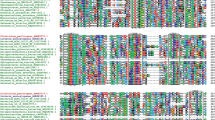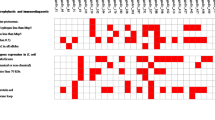Abstract
Recently, the gene coding for a new beta-glucuronidase enzyme has been identified and cloned from Streptococcus equi subsp. zooepidemicus. This is another report of a beta-glucuronidase gene cloned from bacterial species. The ORF Finder analysis of a sequenced DNA (EMBL, AJ890474) revealed a presence of 1,785 bp large ORF potentially coding for a 594 aa protein. Three protein families in (Pfam) domains were identified using the Conserved Domain Database (CDD) analysis: Pfam 02836, glycosyl hydrolases family 2, triose phosphate isomerase (TIM) barrel domain; Pfam 02837, glycosyl hydrolases family 2, sugar binding domain; and Pfam 00703, glycosyl hydrolases family 2, immunoglobulin-like beta-sandwich domain. To gain more insight into the enzymatic activity, the domains were used to generate a bootstrapped unrooted distance tree using ClustalX. The calculated distances for two domains, TIM barrel domain, and sugar-binding domain were comparable and exhibited similarity pattern based on function and thus being in accordance with recently published works confirming beta-glucuronidase activity of the enzyme. The calculated distances and the tree arrangement in the case of centrally positioned immonoglobulin-like beta-sandwich domain were somewhat higher when compared to other two domains but clustering with other beta-glucuronidases was rather clear. Nine proteins, including beta-glucuronidases, beta-galactosidase, and mannosidase were selected for multiple alignment and subsequent distance tree creation.











Similar content being viewed by others
References
Wilson, K. J., Hughes, S. G., & Jefferson, R. A. (1992). The Escherichia coli gus operon: Induction and expression of the gus operon in E. coli and the occurrence and use of GUS in other bacteria. In S. R. Gallagher (Ed.), GUS protocols: using the GUS gene as a reporter of gene expression. San Diego, CA: Academic Press.
Akao, T. (1999). Purification and characterization of glycyrrhetic acid monoglucuronide beta-d-glucuronidase in Eubacterium sp. GLH. Biological and Pharmaceutical Bulletin, 22, 80–82.
Russell, W. M., & Klaenhammer, T. R. (2001). Identification and cloning of gusA, encoding a new beta-glucuronidase from Lactobacillus gasseri ADH. Applied and Environmental Microbiology, 67, 1253–1261.
Jefferson, R. A., Burgess, S. M., & Hirsh, D. (1986). Beta-glucuronidase from Escherichia coli as a gene-fusion marker. Proceedings of the National Academy of Sciences of the United States of America, 83, 8447–8451.
Krahulec, J., & Krahulcová, J. (2007). Characterization of the new β-glucuronidase from Streptococcus equi subsp. zooepidemicus. Applied Microbiology and Biotechnology, 74, 1016–1022.
McCue, P. M., & Wilson, W. D. (1989). Equine mastitis-a review of 28 cases. Equine Veterinary Journal, 21, 351–353.
Shulami, S., Gat, O., Sonenshein, A. L., & Shoham, Y. (1999). The glucuronic acid utilization gene cluster from Bacillus stearothermophilus T-6. Journal of Bacteriology, 181, 3695–3704.
Baudouy, J. R., Portalier, R., & Stoeber, F. (1981). Regulation of hexuronate system genes in Escherichia coli k-12: Multiple regulation of the uxu operon by exuR and uxuR gene products. Journal of Bacteriology, 145, 211–220.
Jacox, R. F. (1953). Streptococcal beta-glucuronidase. Journal of Bacteriology, 65, 700–705.
Jacox, R. F. (1951). Beta-glucuronidase production by beta hemolytic streptococci. Journal of Clinical Investigation, 30, 652.
McGinnis, S., & Madden, T. L. (2004). BLAST: at the core of a powerful and diverse set of sequence analysis tools. Nucleic Acids Research, 32, D20–D25. Available at http://www.ncbi.nlm.nih.gov/BLAST/.
Rombel, I. T., Sykes, K. F., Rayner, S., & Johnston, S. A. (2002). ORF-FINDER: A vector for high-throughput gene identification. Gene, 282, 33–41. Available at http://ncbi.nih.gov/gorf/gorf.html.
Thompson, J. D., Gibson, T. J., Plewniak, F., Jeanmougin, F., & Higgins, D. G. (1997). The ClustalX windows interface: Flexible strategies for multiple sequence alignment aided by quality analysis tools. Nucleic Acids Research, 24, 4876–4882.
Saitou, N., & Nei, M. (1987). The neighbor-joining method: A new method for reconstructing phylogenetic trees. Molecular Biology and Evolution, 4, 406–425.
Marchler-Bauer, A., Anderson, J. B., Cherukuri, P. F., DeWeese-Scott, C., Geer, L. Y., Gwadz, M., et al. (2005). CDD: A conserved domain database for protein classification. Nucleic Acids Research, 33, D192–D196. Available at http://www.ncbi.nlm.nih.gov/Structure/cdd/wrpsb.cgi.
Bateman, A., Coin, L., Durbin, R., Finn, R. D., Hollich, V., Griffiths-Jones, S., et al. (2004). The Pfam protein families database. Nucleic Acids Research, 32, D138–D141.
Wang, Y., Geer, L. Y., Chappey, C., Kans, J. A., & Bryant, S. H. (2000). Cn3D: Sequence and structure views for Entrez. Trends in Biochemical Sciences, 25, 300–302.
Perrière, G., & Gouy, M. (1996). WWW-Query: An on-line retrieval system for biological sequence banks. Biochimie, 78, 364–369.
Henrissat, B. (1991). A classification of glycosyl hydrolases based on amino acid sequence similarities. Biochemical Journal, 280, 309–316.
Henrissat, B., & Bairoch, A. (1993). New families in the classification of glycosyl hydrolases based on amino acid sequence similarities. Biochemical Journal, 293, 781–788.
Henrissat, B., & Bairoch, A. (1996). Updating the sequence-based classification of glycosyl hydrolases. Biochemical Journal, 316, 695–696.
Coutinho, P. M., & Henrissat, B. (1999). Carbohydrate-active enzymes: An integrated database approach. In H. J. Gilbert, G. Davies, B. Henrissat, & B. Svensson (Eds.), Recent advances in carbohydrate bioengineering (pp. 3–12). Cambridge: The Royal Society of Chemistry.
Jacobson, R. H., & Matthews, B. W. (1992). Crystallization of beta-galactosidase from Escherichia coli. Journal of Molecular Biology, 223, 1177–1182.
Juers, D. H., Jacobson, R. H., Wigley, D., Zhang, X. J., Huber, R. E., Tronrud, D. E., et al. (2000). High resolution refinement of beta-galactosidase in a new crystal form reveals multiple metal-binding sites and provides a structural basis for alpha-complementation. Protein Science, 9, 1685–1699.
Nagano, N., Porter, C. T., & Thornton, J. M. (2001). The (β/α)8 glycosidases: Sequence and structure analyses suggest distant evolutionary relationships. Protein Engineering, 11, 845–855.
Rigdena, D. J., Jedrzejas, M. J., & de Melloa, L. V. (2003). Identification and analysis of catalytic TIM barrel domains in seven further glycoside hydrolase families. FEBS Letters, 544, 103–111.
Gebler, J. C., Aebersold, R., & Withers, S. G. (1992). Glu-537, not Glu-461, is the nucleophile in the active site of (lac Z) beta-galactosidase from Escherichia coli. The Journal of Biological Chemistry, 16, 11126–11130.
Cupples, C. G., Miller, J. H., & Huber, R. E. (1990). Determination of the roles of Glu-461 in beta-galactosidase (Escherichia coli) using site-specific mutagenesis. The Journal of Biological Chemistry, 10, 5512–5518.
Skalova, T., Dohnalek, J., Spiwok, V., Lipovova, P., Vondrackova, E., Petrokova, H., et al. (2005). Cold-active beta-galactosidase from Arthrobacter sp. C2–2 forms compact 660 kDa hexamers. Journal of Molecular Biology, 353, 282–294.
Author information
Authors and Affiliations
Corresponding author
Rights and permissions
About this article
Cite this article
Krahulec, J., Szemes, T. & Krahulcová, J. Bioinformatics Characterization of Potential New Beta-Glucuronidase from Streptococcus equi subsp. zooepidemicus . Mol Biotechnol 44, 232–241 (2010). https://doi.org/10.1007/s12033-009-9234-0
Published:
Issue Date:
DOI: https://doi.org/10.1007/s12033-009-9234-0




